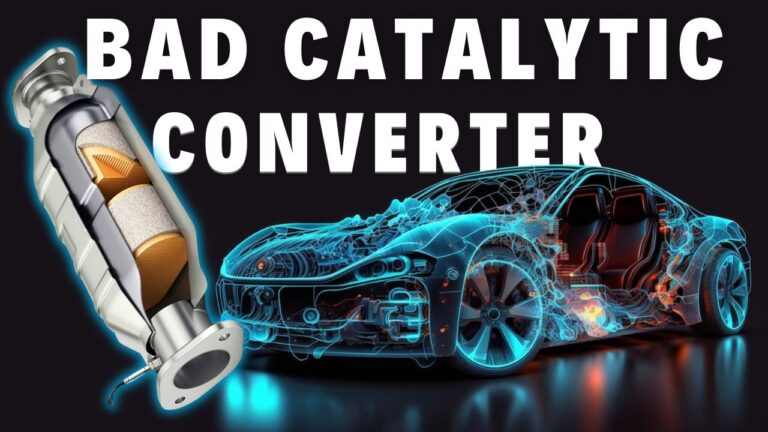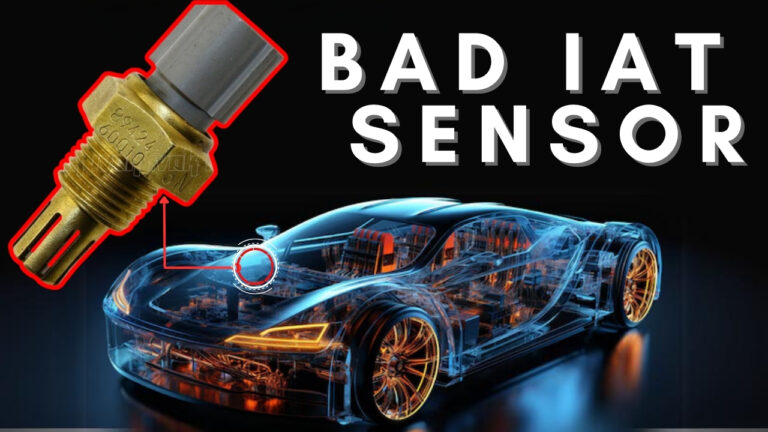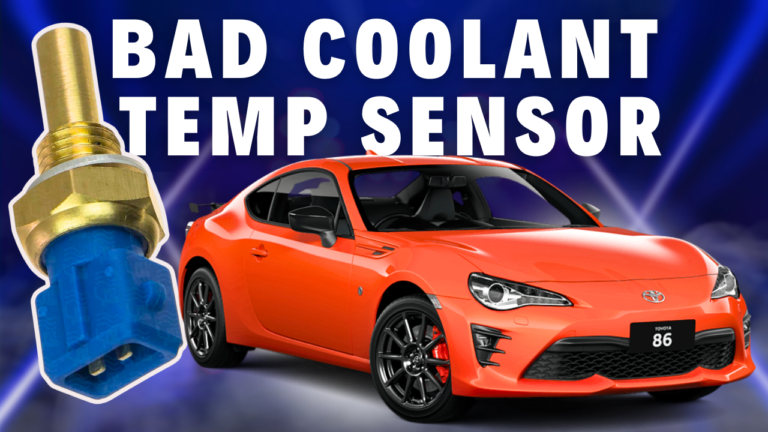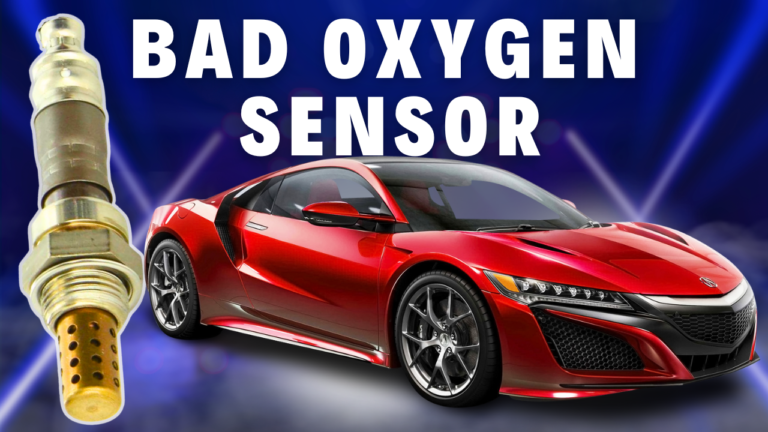Where are the fuse boxes located?
- Passenger compartment fuse panel / power distribution box : The fuse panel is located under the right-hand side of the instrument panel.
- Engine Compartment Relay Box: The power distribution box is located in the engine compartment (left-side).
1. Passenger Compartment

How to access fuse panel ?
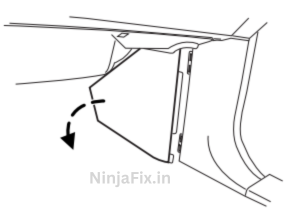
Remove the trim panel and fuse box cover to access the fuses.
To remove the trim panel for access to the fuse box, pull the panel toward you and swing it out away from the side and remove it. To reinstall it, line up the tabs with the
grooves on the panel, then push it shut.
2. Under Hood Fuse Box
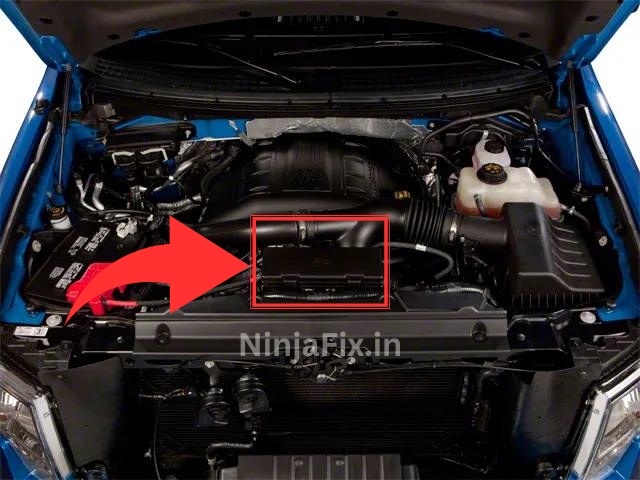
2011 Ford F 150 Fuse Box Diagram
Passenger Compartment Fuse Panel / Power Distribution Box
2011 Ford F 150 Passenger Compartment Fuse Box Diagram
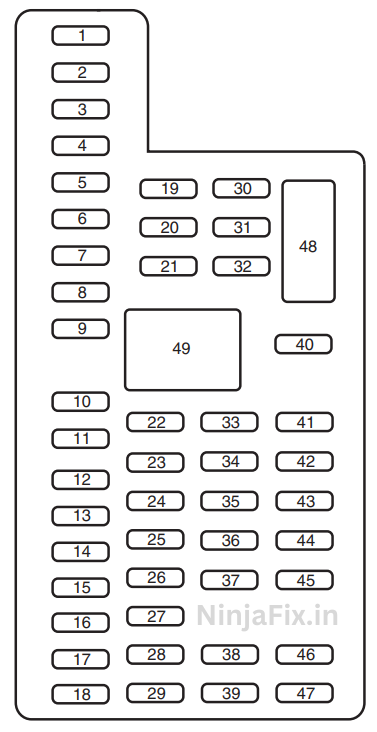
2011 Ford F 150 Passenger Compartment Fuse Details
| № | Amps | Fuse Function |
|---|---|---|
| 1 | 30A | Driver side front window |
| 2 | 15A | SYNC® |
| 3 | 30A | Passenger side front window |
| 4 | 10A | Interior lamps |
| 5 | 20A | Memory module |
| 6 | 5A | Not used (spare) |
| 7 | 7.5A | Power mirror switch, Memory seat module |
| 8 | 10A | Not used (spare) |
| 9 | 10A | Radio display, GPS module, Navigation display |
| 10 | 10A | Run/accessory relay |
| 11 | 10A | Instrument cluster |
| 12 | 15A | Interior lighting, Puddle lamps, Backlighting, Cargo lamp |
| 13 | 15A | Right turn signals/stop lamps |
| 14 | 15A | Left turn signals/stop lamps |
| 15 | 15A | Reverse lights, High-mounted stop lamp |
| 16 | 10A | Right low-beam headlamp |
| 17 | 10A | Left low-beam headlamp |
| 18 | 10A | Brake-shift interlock, Keypad illumination, PCM wakeup, PATS |
| 19 | 20A | Audio amplifier |
| 20 | 20A | Power door locks |
| 21 | 10A | Ambient lighting |
| 22 | 20A | Horn |
| 23 | 15A | Steering wheel control module |
| 24 | 15A | Datalink connector, Steering wheel control module |
| 25 | 15A | Not used (spare) |
| 26 | 5A | Radio frequency module |
| 27 | 20A | Not used (spare) |
| 28 | 15A | Ignition switch |
| 29 | 20A | Radio/Navigation |
| 30 | 15A | Front parking lamps |
| 31 | 5A | BOO – IP, BOO – Engine |
| 32 | 15A | Delay/accessory – moon roof, power windows, locks, Automatic dimming mirror/Compass |
| 33 | 10A | Heated seats |
| 34 | 10A | Reverse sensing system, 4×4 switch, Rear video, Off road indicator (SVT Raptor) |
| 35 | 5A | Hill descent switch (SVT Raptor) |
| 36 | 10A | Restraint control module, Occupant classification system module |
| 37 | 10A | Trailer brake control |
| 38 | 10A | Delayed accessory – 110V power point, Radio (AM/FiM) |
| 39 | 15A | High beam headlamps |
| 40 | 10A | Rear park lamps |
| 41 | 7.5A | Passenger airbag deactivation indicator, Upfitter switch (SVT Raptor) |
| 42 | 5A | Overdrive cancel switch |
| 43 | 10A | Not used (spare) |
| 44 | 10A | Not used (spare) |
| 45 | 5A | Not used (spare) |
| 46 | 10A | Climate controls module |
| 47 | 15A | Fog lamps, Exterior mirror turn signals |
| 48 | 30A Circuit Breaker | Power rear windows, Power sliding back window |
| 49 | Relay | Delayed accessory |
2011 Ford F 150 Under Hood Fuse Box
2011 Ford F 150 Under Hood Fuse Box Diagram
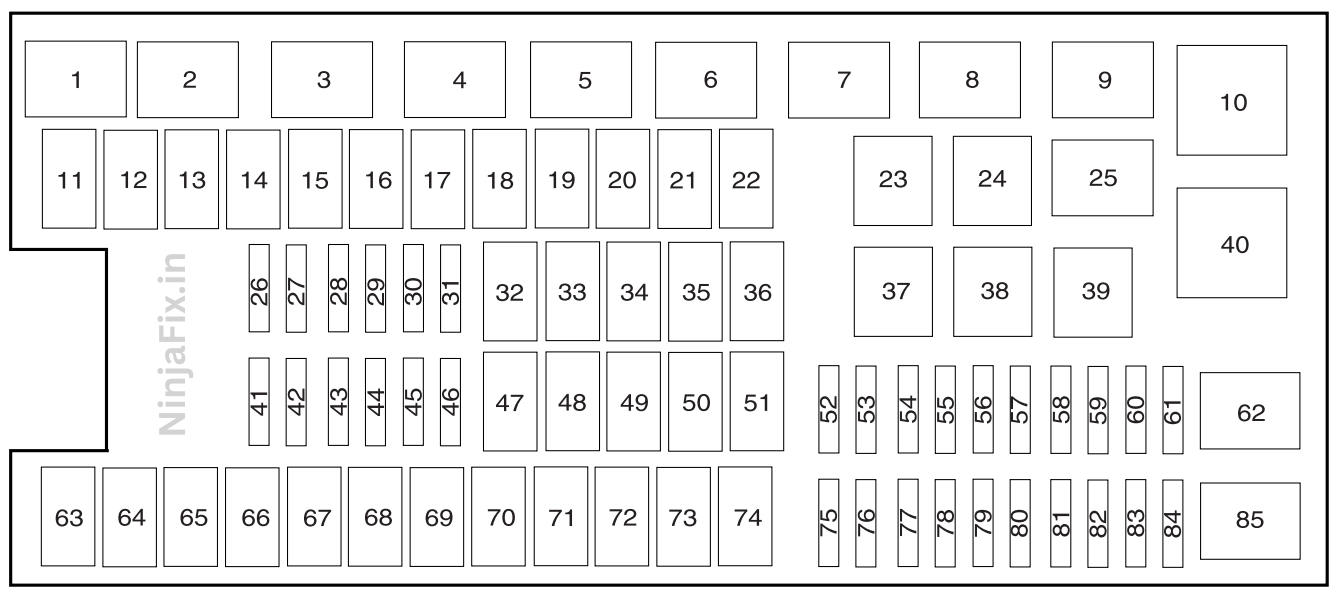
2011 Ford F 150 Under Hood Fuse Box Details
| № | Amps | Fuse Function |
|---|---|---|
| 1 | — | Powertrain control module (PCM) relay (3.7L, 5.0L and 6.2L engines) |
| 2 | — | Starter relay |
| 3 | — | Blower motor relay |
| 4 | — | Rear window defroster relay |
| 5 | — | Electric fan relay (high speed) |
| 6 | — | Trailer tow (TT) park lamp relay |
| 7 | — | Run/start relay |
| 8 | — | Fuel pump relay |
| 9 | — | TT Battery charger relay |
| 10 | — | PCM relay (3.5L engine) |
| 11 | 30A | Power running board motors |
| 12 | 40A | Electric fan |
| 12 | 50A | Electric fan (6.2L with max trailer tow, SVT Raptor) |
| 13 | 30A | Starter relay power |
| 14 | 30A | Passenger power seat |
| 15 | 40A | Electric fan |
| 15 | 50A | Electric fan (6.2L with max trailer tow, SVT Raptor) |
| 16 | — | Not used |
| 17 | 30A | Trailer brake control |
| 18 | 30A | Upfitter 1 (SVT Raptor) |
| 19 | 30A | Upfitter 2 (SVT Raptor) |
| 20 | 20A | 4×4 module (electronic shift) |
| 21 | 30A | TT battery charge relay power |
| 22 | 20A | Cigar lighter |
| 23 | — | A/C clutch relay |
| 24 | — | Not used |
| 25 | — | Vacuum pump relay (3.5L engine) |
| 26 | 10 A | PCM – keep alive power, PCM relay coil, canister vent solenoid (3.7L, 5.0L and 6.2L engines) |
| 27 | 20 A | Fuel pump relay power |
| 28 | 10 A | Upfitter 4 (SVT Raptor) |
| 29 | 10 A | 4×4 IWE solenoid |
| 30 | 10 A | A/C clutch |
| 31 | 15 A | Run/start relay power |
| 32 | 40A | Rear window defroster relay power |
| 33 | 40A | 110V AC power point |
| 34 | 40A | PCM relay power (3.7L, 5.0L and 6.2L engines) |
| 34 | 50A | PCM relay power (3.5L engine) |
| 35 | — | Not used |
| 36 | 30A | Roll stability control (RSC)/Anti-lock brake system (ABS) |
| 37 | — | TT left stop/turn relay |
| 38 | — | TT right stop/turn relay |
| 39 | — | TT back-up lamps relay |
| 40 | — | Electric fan relay |
| 41 | — | Not used |
| 42 | 5A | Run/start coil |
| 43 | 15 A | TT back-up lamp relay power |
| 44 | 15 A | Upfitter 3 (SVT Raptor) |
| 45 | 10 A | Alternator sensor (non-6.2L engines) |
| 46 | 10 A | Brake on/off (BOO) switch |
| 47 | 60A | RSC/ABS module |
| 48 | 20A | Moon roof |
| 49 | 30A | Wipers |
| 50 | — | Not used |
| 51 | 40A | Blower motor relay power |
| 52 | 5A | Run/start – Electronic power assist steering, Blower relay coil |
| 53 | 5A | Run/start – PCM |
| 54 | 5A | Run/start – 4×4 module, Back-up lamps, RSC/ABS, TT battery charge relay coil, Rear window defroster relay coil |
| 55 | — | Not used |
| 56 | 15 A | Heated mirrors |
| 57 | — | Not used |
| 58 | — | Not used |
| 59 | — | Not used |
| 60 | — | Not used |
| 61 | — | Not used |
| 62 | — | Wiper motor relay |
| 63 | 25A | Electric fan |
| 64 | 40A | Vacuum pump relay power (3.5L engine) |
| 65 | 20A | Auxiliary power point (instrument panel) |
| 66 | 20A | Auxiliary power point (inside center console) |
| 67 | 20A | TT park lamps relay power |
| 68 | 25A | 4×4 module |
| 69 | 30A | Passenger heated/cooled seats |
| 70 | — | Not used |
| 71 | 20A | Heated rear seats |
| 72 | 20A | Auxiliary power point (Rear) |
| 73 | 20A | TT stop/turn lamps relay power |
| 74 | 30A | Driver power seat/memory module |
| 75 | 15 A | PCM – voltage power 1 (3.7L, 5.0L, 6.2L engines PCM module) |
| 75 | 25A | PCM – voltage power 1 (3.5L engine PCM module) |
| 76 | 20 A | PCM – Voltage power 2 (General powertrain components, Mass air flow/Intake air temp sensor) (3.7L, 5.0L, 6.2L engines) |
| 76 | 20 A | PCM – Voltage power 2 (General powertrain components, Canister vent solenoid) (3.5L engine) |
| 77 | 10 A | PCM – Voltage power 3 (Emission related powertrain components, Electric fan relays coil) |
| 78 | 15 A | PCM – Voltage power 4 – Ignition coils (3.5L, 3.7L, 5.0L engines) |
| 78 | 20 A | PCM – Voltage power 4 – Ignition coils (6.2L engine) |
| 79 | 5A | Rain sensor |
| 80 | — | Not used |
| 81 | — | Not used |
| 82 | — | Not used |
| 83 | — | Not used |
| 84 | — | Not used |
| 85 | — | Electric fan relay (low speed) |
WARNING: The terminal and harness assignments for individual connectors may vary depending on the vehicle’s equipment level, model, and market. It is recommended to refer to the fuse box diagram provided at the back of the fuse box cover for accurate information.

